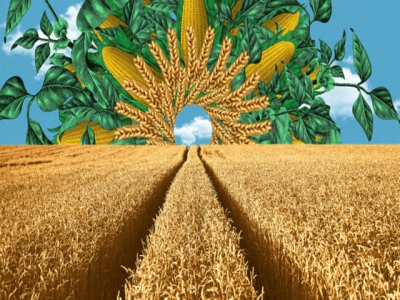3 reasons agriculture is poised for a surge of sustainable innovation

To transition to more sustainable practices, farmers need better policy, better tech, and more access to capital. All could be coming soon.
Source Images: Rasmus Landgreen/Unsplash
While the use of sustainable agricultural practices has a multitude of environmental and production benefits, farmers face many barriers to adoption, including increased uncertainty of yields, a lack of expert technical assistance, a lack of the right equipment or technology, and most notably, the high cost of implementation.
The transition to sustainable farming requires conventional farmers to learn about new equipment, practices, and regulations. The largest source of farmer knowledge and technical assistance, county extension services, are geared toward conventional growers and woefully understaffed with organic and regenerative specialists needed for farmers to successfully transition.
Even with the right equipment, a farm cannot function without the workers to operate it. Tight profit margins in todays economic environment make hiring farm workers a challenge, and the ability to hire foreign workers through the federal government’s H2-A program requires hefty upfront expenses for transportation, attorneys, and housing that some farmers simply cannot afford.
For farmers weighing the risks and benefits of transitioning to more climate-smart agricultural practices, the high costs associated with transitioning remain one of the biggest obstacles. First, costs can be hard to predict, as climate-smart farming is not one-size-fits-all; the techniques are site-specific and determined by local weather and soil. Although certain financial incentive programs and overall economic benefits can help farmers enjoy increased profitability than conventional methods, the initial challenge of investing in necessary equipment can be daunting.
While the federal government has implemented some cost-sharing programs for farms seeking to grow more sustainably, the vast majority of federal farm support goes to the largest farms. In 2016, 60% of farm subsidies went to the richest 10% of farmers, many of whom work the land in ways that are fossil fuel intensive, exhaust soils, emit carbon, and contribute to the climate crisis.
Additionally, government support of regenerative practices is just beginning. Whereas conventional practices are often supported through tax breaks and subsidies, funding and research programs for soil improvement techniques do not yet enjoy the same level of support. In fact, a recent study found that the Environmental Quality Incentives Program (EQIP)—a federal program designed to deliver improved water quality and increase soil health—has strayed from its goals in recent years. In 2018, for example, soil boosting funding represented less than 1% of the United States Department of Agriculture’s total annual expenditures.
Yet, on-farm innovation, combined with new policy and advances in technology, offer the American agricultural sector with an array of hopeful solutions. Here’s why I am optimistic about the future of agriculture:
NEW OPPORTUNITIES FOR AGTECH INNOVATION
Agtech research and development is growing rapidly, with investment in the field growing 370% over the last six years. From seed technologies to AI to precision farming software, the industry is rife with innovation as it seeks resilient, adaptive solutions to challenges posed by the climate emergency.
Some of the new innovators of agriculture are looking at the small—microscopically small—to innovate the sector toward a sustainable future. Indigo Ag, for example, is betting big on microbe-coated commodity seeds that can better resist pest pressure and severe weather challenges, while allowing farmers to decrease their use of pesticides and synthetic fertilizers. Since inception, IndigoAg has built many more products on the same premise to advance regenerative agriculture, including an online grain marketplace and its voluntary carbon credit program.
Other agtech innovations look to increase farm efficiency and decrease input waste through precision farming techniques. Precision farming utilizes satellite technology, information systems, and remote sensing in order to maximize yield while minimizing environmental footprint. Internet of Things (IoT) sensors, for example, can be used to track soil moisture, changes in the microclimate of a field, soil carbon and micronutrient levels, and rates of plant growth throughout harvest cycles. GPS technology makes planting and input application far more accurate than manual tractor methods, meaning that farmers can decrease waste and excess fertilizer use.
As the planet warms, certain farm tasks are increasingly dangerous for humans to perform at the height of summer heat. Autonomous vehicles could replace farmworkers in these situations. Areas with farmworker labor shortages could also benefit from the evolution of on-farm robotics. Farmers are also taking robotics into the skies with the continued evolution of drone technology. Drones can provide farmers with valuable data that helps them assess their needs for fertilizer, drainage, additional irrigation, or other necessary farm improvements. Additionally, some robots and drones are now outfitted with AI or machine learning technology, which enables farmers with immediate information to process improvements.
While these opportunities are exciting for the agricultural sector as a whole, their price tag is hefty. Farmers need access to investment funds in order to make the transition.
NEW OPPORTUNITIES FOR INVESTMENT
Innovation driven by climate change is charting the future of agriculture, in which farms will be more productive, more resilient, and climate restoring. Farms that make the change may have a competitive advantage, but adaptation—especially early adoption—is costly.
At the same time, many farms are already financially stressed. Just as agricultural technology is undergoing massive innovation, so too must the financial technology that serves farmers. Farmers need investment in order to bring agtech advances to bear on farms, but traditional bank loans and mandated insurance programs have a mixed history, and many farmers are growing increasingly wary.
A robust American food system requires an agile, climate-smart agricultural sector that can both adapt to changing weather patterns and do its part to mitigate environmental impact. Implementing sustainable practices is not without cost, and farmers have too long carried the financial burden of the problems in our food system through ever-increasing debt. The time is ripe for change.
Fortunately, new platforms (like FarmTogether, where I’m the CEO) have opened up farm investments for individual retail investors, channeling the capital required for sustainable transitions while allowing crowdsourcing options for smaller investors. These fintech platforms are often more adaptive and data driven than traditional financing approaches, so farms can be more resilient against year-to-year fluctuations.
Through democratized investment capabilities that bring a new class of investors to a cash-strapped sector, we can all take part in sowing the seeds of a new future for American farmers.
NEW OPPORTUNITIES FOR POLICY IMPROVEMENTS
Creating a new, innovative agricultural sector that can respond to the challenges of the climate emergency requires the support of the government through smart federal policy. Certain programs, like the Natural Resources Conservation Service (NRCS) and EQIP, already exist to help farms transition to sustainable practices, but the programs are small, exclusive, and limited in capacity. In order to increase efficacy, these programs need to be widely available to more growers.
The National Sustainable Agriculture Coalition (NSAC) is a policy group developed over three decades ago that helped define sustainable agriculture for the 1990 Farm Bill. NSAC has developed an extensive list of policy recommendations for the upcoming 2023 Farm Bill that will help U.S. farmers mitigate their impact on the climate, remove financial barriers to entry for farmers wishing to adopt sustainable practices, and provide research and development funding for resilient agricultural techniques.
Other policy proposals reflect on our past to build a better future. A century ago, in the wake of the Dust Bowl and the Great Depression, President Roosevelt and Congress passed the New Deal. It created supply management policies in order to create a price floor for American farmers, and in recent years, we have seen a strong push to revive it.
Senator Cory Booker reintroduced a bill in July that seeks to break up food system monopolies, level the playing field for family farms, and create a more resilient agricultural sector. The Farm Systems Reform Act would also place a cap on the number of CAFOs (Confined Animal Feeding Operations) in order to make smaller family farms more competitive, curb methane emissions, and protect water quality.
One of the most intriguing services being adopted is the concept of a carbon market, in which a farm’s financial returns will not only come from crop yield and price, but also from credits for carbon sequestration in the soil. There is also the potential for increased land value from increased productivity per acre. The concept behind the design of carbon markets could be applied to other resources as well, such as water or oxygen. The Biden Administration has thrown its support behind soil carbon markets, making soil sequestration a key aspect of its greenhouse gas reduction target. State governments are also lending their support to soil health and carbon sequestration, with California, Vermont, Illinois, Nebraska, and New Mexico passing healthy soils legislation in 2019.
WHAT WILL BE THE FUTURE OF OUR PLANET?
The agricultural sector is at a pivotal and exciting crossroads, with innovations in agricultural technology, farmland investment platforms, and smart soil policy bolstering the food system in its efforts to both mitigate its impact on the climate as well as adapt to changing weather patterns. Farmers need financial and technical assistance in order to make their farms more resilient to the negative impacts of climate change. Through regenerative, climate-smart farming methods, the agricultural sector is uniquely positioned to lead American businesses on the path of a low-carbon future.
Related news
Tools

Phối trộn thức ăn chăn nuôi

Pha dung dịch thủy canh

Định mức cho tôm ăn

Phối trộn phân bón NPK

Xác định tỷ lệ tôm sống

Chuyển đổi đơn vị phân bón

Xác định công suất sục khí

Chuyển đổi đơn vị tôm

Tính diện tích nhà kính

Tính thể tích ao



 Vietnam's five-percent broken rice price increases in foreign…
Vietnam's five-percent broken rice price increases in foreign…  New hope for Binh Thuan dragon fruit
New hope for Binh Thuan dragon fruit